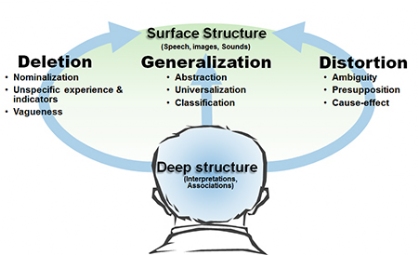Meta model of language
The meta model of language describes mechanisms that filter specific content during the formulation of statements. The model was originally developed by NLP founders Richard Bandler and John Grinder based on the linguistic patterns of Milton Erickson. Thoughts from the deep structure are converted into language, pictures, and sounds of the Surface Structure during the process of formulation. Since not all impressions of the deep structure can be converted, Information get lost – might be missing expressions or unconscious filtering.
Besides the hypno-therapeutic effects aimed for in NLP, the model can be used in everyday communication for improvement of messages. Filtering is partly compensated for example as an adjustment to the profile of the target audience. The message becomes more concrete, clear-cut and offers hands-on course of action. The substantial mechanisms are deletion, generalization and distortion.

Generally, information content always changes with the transfer from the deep to the surface structure. This happens on one hand by filtering content. On the other hand, content creates new association potentials through subjective interpretation of language, images and sounds that goes far beyond intended effect. A clear profile of the target audience and conscious use of the meta model increase the information content and reduce awkward messages.
Deletion
Deletion simply omits information contents by using abstract nouns (nominalization), not detailing facts (unspecific experiences/ indicators) as well as remaining unclear about people and things (vagueness). Receivers fill the missing information with their own experiences. Examples are: requirements are clear (which requirements? what means clearly?); satisfaction increased (satisfaction concerning what? Increased from … to?).
Generalization
Generalization selects linguistic forms that leave the message undefined, e.g. by missing orders of magnitude (abstraction), suggesting derivatives (universalization) and building structures (classification). Generalization gets lost in commonality and leaves to the receivers their personal detailing. Examples are: most people carried out a lot (What percentage of people? How many people? What means carried out a lot?); one has always difficulties (Who exactly? Without Exception?).
Distortion
Distortion produces difficulties from the use of homonyms, synonyms, acronyms, or heteronyms (ambiguity), Beliefs, quotations or expectations (presupposition) as well as from analogies, metaphors and causal loops that suggest coerciveness (cause-effect). Receivers decide to add their own interpretations, presuppositions, as well as relations to the message. Examples are: certain parts end up on garbage (parts are selected, decided, designated, or counted?); airfreight to the west get lost (only air freight? other directions?).
With deletion, generalization and distortion the sender leaves it to the receiver to interpret in a more or less predefined direction, since each receiver add their own information. Skillful deletion of content that produce contradiction increases acceptance of the message. Conscious handling of the meta model of language makes it possible for sender to improve messages consciously by skillfully erasing, generalizing and distorting. Following the motto: a picture says more than a thousand words.
